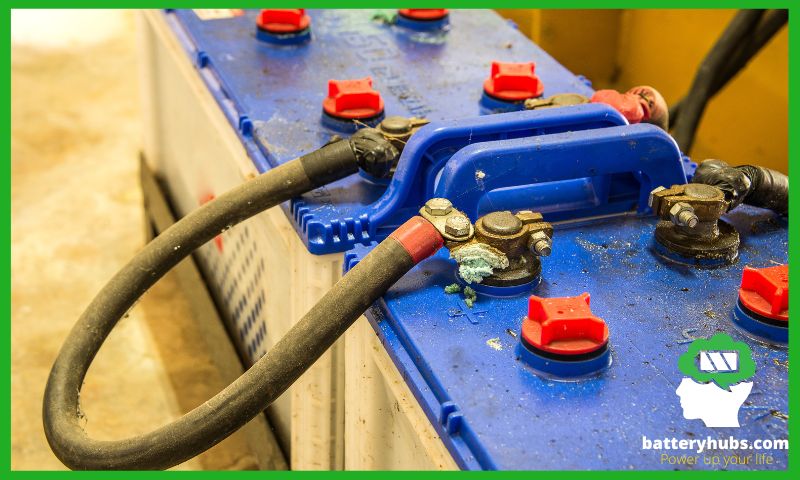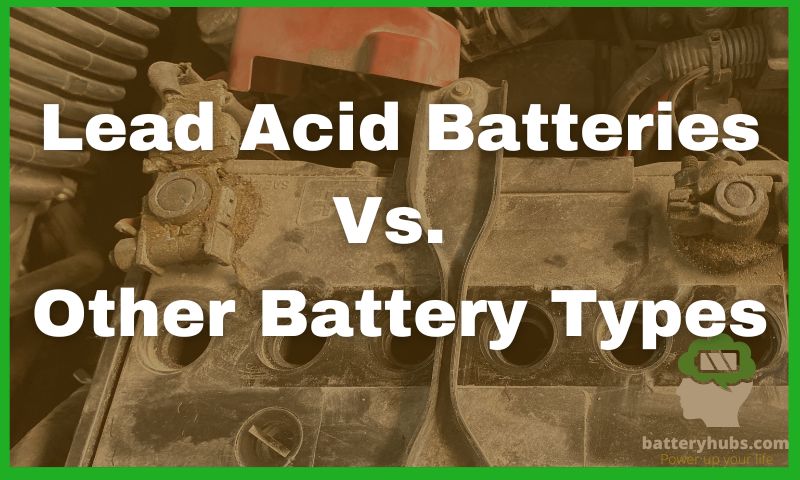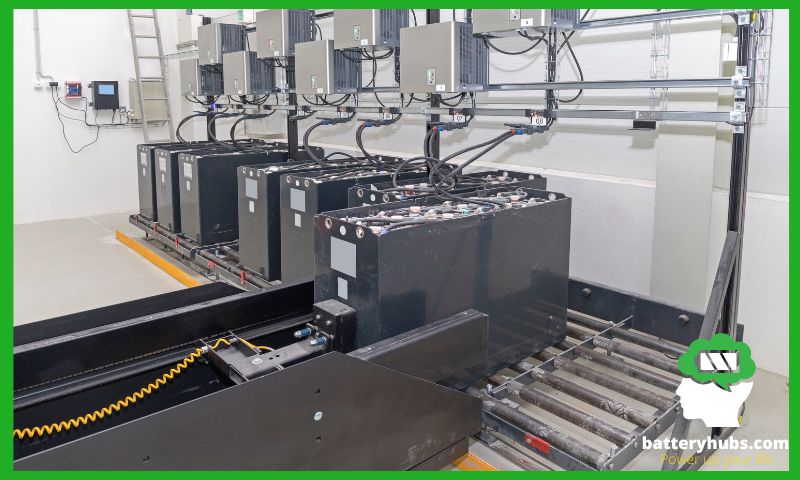Lead-acid batteries are favored for their affordability, robustness, and high surge currents. Despite lower energy-to-weight ratios than other types, they are highly reliable and recyclable. Their ability to deliver high currents makes them suitable for starting vehicles and other heavy-duty applications.
I’ve spent the better part of my career, which is oh, just about two decades now, fiddling with and marveling at batteries of all shapes and sizes. And let me tell you, there’s nothing quite like the charm of a lead-acid battery.
Why, you ask? Well, it’s simple really. These little powerhouses have been around since 1859 (yep, you read that right). That’s over 160 years! They were the first rechargeable batteries for commercial use and guess what? They’re still very much in the game. They power our cars, store energy for our solar panels, and keep data centers humming.
In this post, I’m going to share with you all the reasons I’m absolutely smitten with these enduring marvels of energy storage. So, buckle up and get ready for a deep dive into the world of lead-acid batteries!
The Science Behind Lead Acid Batteries

Well, folks, it’s time for a trip down memory lane. Or rather, chemistry lane. I promise it’s not as daunting as it sounds.
The Chemistry of a Lead Acid Battery
You see, the magic (or shall we say, chemistry) that powers our beloved lead-acid batteries revolves around a simple chemical reaction. When the battery discharges, the lead dioxide (PbO2) positive plate reacts with the sulfuric acid (H2SO4) electrolyte and the sponge lead (Pb) negative plate to produce lead sulfate (PbSO4) and water (H2O).
Here’s the chemical reaction for you visual learners out there:
PbO2 + H2SO4 + 3Pb -> 4PbSO4 + 2H2O
And when do we charge the battery? The process is reversed, of course! The lead sulfate and water are converted back to lead dioxide, sulfuric acid, and lead. It’s like a magic trick, but it’s just good old chemistry at work.
The Principle and Functioning of a Lead Acid Battery
Now that we’ve got the chemistry sorted, let’s talk about how these batteries actually work.
In essence, lead-acid batteries are a little like me after a cup of coffee – they spring into action, ready to get things moving. When you turn the key in your ignition, or your solar panel system needs to store energy, the chemical reaction we talked about above kicks off.
As the battery discharges, the acid in the electrolyte reacts with the materials of the plates (lead and lead dioxide), converting them into lead sulfate. This reaction produces electrons. And those electrons? They’re what provide the electric current to power your car or store your solar energy.
When the battery is charged, the whole process goes into reverse. The lead sulfate is converted back into lead, lead dioxide, and sulfuric acid. And just like that, the battery is ready for another round!
Now, wasn’t that a fun trip? I certainly think so! But don’t go away just yet. We’ve got plenty more to uncover about these ever-dependable, lead-acid powerhouses. So, stay tuned, and let’s delve deeper into the wonderful world of batteries!
Benefits of Lead Acid Batteries
Alright, let’s keep the momentum going. So, we’ve talked about the science, but why do I sing praises of the humble lead-acid battery so often? Well, they’re a bit like a dependable old friend. They may not be flashy, but you know you can always count on them. Here are some reasons why.
Cost-Effectiveness
First off, lead-acid batteries are a bargain. I mean, who doesn’t love a good deal, right? When compared to other batteries like lithium-ion or nickel-cadmium, lead-acid batteries are usually much more affordable. But don’t let the price tag fool you. These batteries pack a punch and give you a real bang for your buck.
Proven Reliability
Did I mention that lead-acid batteries have been around since 1859? That’s longer than any other type of rechargeable battery. Talk about standing the test of time! They’ve been used in everything from starting cars to backing up data centers to storing renewable energy. If that doesn’t scream reliability, I don’t know what does.
High Power Capacity
Another reason why I love these batteries is their high power capacity. They might be old, but they sure are powerful. Lead-acid batteries are capable of delivering large bursts of current, making them ideal for applications like starting a car engine. So next time you rev your engine, remember to thank your trusty lead-acid battery.
Easy Recycling
Finally, one of the best things about lead-acid batteries is that they’re highly recyclable. In fact, more than 99% of all battery lead is recycled. As a battery guru, I can’t stress enough how important this is. It’s not just about providing power; it’s about doing it sustainably.
Well, there you have it, folks. These are just some of the reasons why lead-acid batteries have remained a firm favorite for over a century. But hang on, we’re not done yet. Let’s see how they stack up against some of their competitors, shall we?
Comparative Analysis: Lead Acid Batteries vs. Other Battery Types

So, we’ve talked about the many merits of lead-acid batteries. But how do they compare to other popular types of batteries? I’m glad you asked! Let’s put our lead-acid heroes head-to-head with some worthy competitors: lithium-ion and nickel-cadmium batteries.
Lead Acid vs. Lithium-Ion
Lithium-ion batteries might be the new kids on the block, but they’ve quickly become a popular choice, especially for portable electronics. But how do they stack up against our old friend, the lead-acid battery? Let’s find out.
| Aspect | Lead Acid | Lithium-ion |
|---|---|---|
| Cost | Generally cheaper | More expensive |
| Safety | Safe, but requires proper handling due to corrosive acid | Generally safe, but can overheat |
| Performance | Excellent for high power applications | Superior energy density, great for portable electronics |
As you can see, while lithium-ion batteries have the edge in energy density, lead-acid batteries are still the go-to for high-power applications like starting your car. Plus, they’re gentler on your wallet.
Lead Acid vs. Nickel-Cadmium
Now, let’s look at nickel-cadmium batteries. They’ve got some good features, but when it comes to environmental impact, it’s a different story. Check it out.
| Aspect | Lead Acid | Nickel-Cadmium |
|---|---|---|
| Environmental Impact | Highly recyclable | Contains toxic heavy metals, difficult to dispose of |
| Performance | High power, lower energy density | Good for lower power, long life applications |
As you can see, lead-acid batteries take the cake when it comes to environmental friendliness. Over 99% of lead-acid batteries are recycled. Nickel-cadmium batteries, on the other hand, contain toxic heavy metals and are a real pain to dispose of properly.
So there you have it. When it comes to cost-effectiveness, reliability, power, and recyclability, lead-acid batteries are tough to beat. But stay tuned, because we’re not done yet. Up next, we’ll delve into the many applications of these versatile powerhouses.
Applications of Lead Acid Batteries

By now, I bet you’re pretty impressed with our trusty lead-acid batteries. But hold on to your hats, folks, because we haven’t even touched on all the places you can find these handy little powerhouses. From cars to wind turbines to golf carts, lead-acid batteries are everywhere. Let’s take a look.
Use in Automobiles
If you’ve ever driven a car, you’ve got a lead-acid battery to thank. These batteries are the unsung heroes of the automotive world, responsible for the starter, light, and ignition (SLI) systems in virtually every vehicle on the road. Next time you turn on your headlights or start your engine, remember to send a little gratitude to the lead-acid battery working hard under the hood.
Renewable Energy Storage
When the sun’s shining or the wind’s blowing, we need a way to store all that lovely renewable energy. Enter lead-acid batteries. They’re the perfect companions for solar panels and wind turbines, storing energy during peak production times so we can use it when we need it. It’s like having a savings account but for energy!
Uninterruptible Power Supplies (UPS)
You know those moments when the power goes out, and you’re left scrambling in the dark? That’s when uninterruptible power supplies (UPS) come in handy. And guess what’s at the heart of these backup systems? You guessed it: lead-acid batteries. They provide reliable, instant power, ensuring industries and data centers keep running smoothly, even when the grid lets us down.
Recreational: Boats, Golf Carts, Wheelchairs, etc.
Last but not least, lead-acid batteries make our leisure time a whole lot more enjoyable. Whether you’re cruising on a boat, teeing off on the golf course, or exploring the neighborhood in a power wheelchair, you can bet a lead-acid battery is behind the scenes, making it all possible.
So, from powering our cars to backing up our industries, storing renewable energy, and even making our leisure time more enjoyable, lead-acid batteries are a truly versatile bunch. And with their affordable price tag and impressive recyclability, they’re not just good for us, they’re good for our planet, too. So here’s to the humble lead-acid battery – a true jack of all trades and a master of many!
Future of Lead Acid Batteries
Now that we’ve taken a journey through the past and present of lead-acid batteries, it’s time to gaze into our crystal ball and see what the future holds. Will lead-acid batteries still have a role in our ever-evolving energy landscape? Let’s find out.
Innovations and Improvements in Lead Acid Battery Technology
Contrary to what you might think, lead-acid battery technology isn’t stuck in the past. It’s continuously evolving, with new innovations and improvements emerging all the time. We’re talking about advancements in areas like carbon additives that boost performance, life expectancy, and charge acceptance. These improvements mean that our old friend is getting better with age, like a fine wine. So, rest assured, lead-acid batteries aren’t going anywhere anytime soon.
Role of Lead Acid Batteries in the Future Energy Landscape
If you’re worried about the place of lead-acid batteries in our future energy landscape, let me put your mind at ease. As we shift towards renewable energy sources, the need for reliable energy storage only grows. And guess who’s ready to step up to the plate? You got it: lead-acid batteries.
With their reliability, high power capacity, and ability to be recycled, lead-acid batteries are poised to play a significant role in our green energy future. Whether it’s serving as backup power for solar arrays and wind farms, or powering electric vehicles and smart grids, these batteries have the potential to be at the heart of our sustainable energy solutions.
So, as we move towards a more sustainable, energy-efficient future, lead-acid batteries are set to be right there with us, every step of the way. And with continuous innovation and improvement, who knows what these versatile powerhouses will be capable of in the years to come?
Conclusion
Well, my friends, we’ve taken quite a journey together through the world of lead-acid batteries. From their humble beginnings in the 19th century to their pivotal role in our modern energy landscape, these trusty powerhouses have proven their worth time and time again.
We’ve delved into the science that makes them tick, marveled at their versatility, and looked ahead to their bright future. And through it all, one thing has become abundantly clear: lead-acid batteries aren’t just a part of our past; they’re an essential part of our present and our future, too.
With their cost-effectiveness, proven reliability, high power capacity, and impressive recyclability, it’s no wonder these batteries have stood the test of time. And with ongoing innovation and improvements, their potential is only set to grow.
So, whether you’re powering your car, storing renewable energy, ensuring backup power in an emergency, or just enjoying a leisurely round of golf, remember the humble lead-acid battery that makes it all possible. They may not be flashy or high-tech, but these reliable workhorses are an essential part of our daily lives, and they deserve a bit of recognition.
I hope our journey has given you a newfound appreciation for these unsung heroes of the battery world. After all, where would we be without them? As for me, I’m off to charge my electric golf cart and enjoy a round on the green – all thanks to my trusty lead-acid battery.
When it comes to the world of batteries, lead-acid variants are the tried and true workhorses that keep our world spinning. Their enduring popularity is no accident. Rather, it’s a testament to their inherent qualities and the innovative improvements made over the years.
For those of you who are new to this world and still wondering, “what is a lead acid battery?” and “why is it called a lead-acid battery?”, I encourage you to take a deep dive into our other articles. They’ll provide you with a wealth of knowledge and make you a battery enthusiast in no time.
If you’re interested in learning more about the practical uses of these energy powerhouses, our piece on “what is a lead-acid battery used for?” will certainly be of interest. You’ll discover the wide array of applications that rely on lead-acid batteries, from cars to renewable energy systems, and much more.
For those curious about the different types of lead-acid batteries and how they stack up against the competition, our articles on “what are the 3 types of lead-acid batteries?” and “what is the difference between lead-acid and lithium batteries?” will serve you well.
As you navigate your way through the ever-evolving world of batteries, remember that knowledge is power (no pun intended). Keep learning, stay curious, and you’ll be a battery guru before you know it.
Thank you for joining me on this electrifying journey through the realm of lead-acid batteries. Here’s to many more enlightening discussions and discoveries! Until then, keep your batteries charged and your energy high.
FAQ
Why is lead acid better than lithium?
Lead acid batteries have several advantages over lithium batteries. They are cost-effective, highly reliable, and provide a high power capacity. While lithium batteries have a higher energy density, lead acid batteries are capable of delivering large amounts of current, making them suitable for applications such as car starting where high power is needed for a short time. Lead acid batteries are also easier to recycle than lithium batteries, which adds to their appeal.
Why are lead acid batteries popular?
Lead acid batteries are popular for several reasons. Firstly, they have a long history of use in various applications, giving them a proven track record of reliability. They’re also cost-effective, provide good value for money, and have a high power capacity. Additionally, lead acid batteries are highly recyclable, contributing to their popularity.
Why do we use lead-acid batteries instead of lithium-ion batteries?
The choice between lead-acid and lithium-ion batteries largely depends on the specific application. Lead acid batteries are often chosen for their cost-effectiveness, reliability, and high power capacity. They’re particularly suitable for applications requiring high power over a short period, such as starting a car. While lithium-ion batteries have a higher energy density, they also tend to be more expensive and less recyclable than lead-acid batteries.
Do lead-acid batteries last longer than lithium?
The lifespan of a battery depends on several factors, including the specific type of battery, its usage, and how well it’s maintained. On average, both lead-acid and lithium-ion batteries can last several years. However, lithium-ion batteries tend to have a longer lifespan under optimal conditions. It’s important to note that both types of batteries require proper care and maintenance to reach their maximum lifespan.
Why are lead-acid batteries not used in electric cars?
Electric cars typically require batteries with a high energy density, which is the amount of energy a battery can store relative to its weight. While lead-acid batteries are reliable and cost-effective, they have a lower energy density compared to lithium-ion batteries. This makes lithium-ion batteries a more suitable choice for electric cars, which need to store a large amount of energy without adding excessive weight.
Why don’t lead acid batteries last forever?
Like all batteries, lead-acid batteries have a limited lifespan. This is due to a process called sulfation, where lead sulfate crystals form on the battery plates over time. This can reduce the battery’s capacity and eventually lead to failure. Regular charging and maintenance can help delay this process, but eventually, all lead-acid batteries will need to be replaced.
Why are lead acid batteries cheap?
Lead acid batteries are relatively cheap to produce, partly due to the abundance and affordability of their main components – lead and sulfuric acid. Their design and manufacturing process are also well-established, which helps to keep costs down. Additionally, the cost of recycling lead-acid batteries is lower compared to other types of batteries, which can also contribute to their overall affordability.
